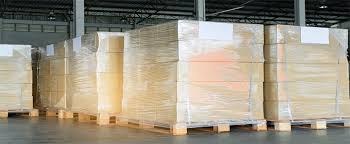In today’s fast-paced market, efficient packaging solutions have never been more crucial, especially for businesses that rely heavily on distribution and logistics. One of the most effective ways to ensure that products are transported safely and securely is through the proper use of pallet wrapping. This blog post aims to explore easy pallet wrapping solutions that can streamline packaging processes, enhance product safety during transportation, and ultimately save businesses time and money.
Pallet wrapping, when done effectively, provides stability to items being shipped, reduces incidents of package damage, and can even deter theft. Choosing the right wrapping method can have significant implications for operational efficiency. In this post, we discuss some key facets to consider for simple yet proficient pallet wrapping applications that cater to various logistical needs.

Understanding Different Types of Pallet Wraps
Before diving into techniques and technologies, it’s fundamental to understand the different types of pallet wraps available in the market. The most commonly used materials include stretch film and shrink wrap. Stretch film is versatile and cost-effective, ideal for stabilizing loads with its elastic recovery feature. On the other hand, shrink wrap provides a tighter seal around goods but requires heat application, making it slightly more complex in terms of application. Both types play crucial roles and are suited for different packaging requirements which can impact your decision on selecting the appropriate wrap for your needs.
Additionally, considering Secure Pallet Wrapping, a product or service that guarantees durability and reliability, could further enhance packing efficiency and safety. It’s important to assess these options based on the specific demands of your products and logistical arrangements.
Automated vs Manual Pallet Wrapping
Choosing between automated and manual pallet wrapping can significantly affect your packing efficiency. Manual wrapping may be suitable for smaller operations or lower volume needs where purchasing specialized machinery does not justify the cost. However, automated systems offer consistency in wrap application, increased speed, and typically fewer material costs over time due to precise control and reduced waste.
Investing in an automated wrapper might seem upfront costly but can pay off by minimizing labor costs and enhancing wrap efficiency. Evaluate your operation’s size and growth potential to determine if transitioning from manual to automated systems could scale your packaging process more effectively.
Innovative Techniques in Pallet Wrapping
New technologies are continually emerging in the field of pallet wrapping, which can revolutionize your packaging operations. For example, pre-stretched films require less energy to apply while maintaining superior load holding capabilities. Another innovation includes nano technology in stretch films which uses several layers of ultra-thin film that are highly resistant to punctures while offering increased load stability.
Adopting these innovative solutions not only contributes positively environmental by reducing waste but also improves your overall operational efficiency by necessitating less product usage without compromising package security.
Sustainability in Pallet Wrapping
Sustainability concerns are prompting companies to rethink their packaging strategies with a growing focus on eco-friendly solutions. Biodegradable pallet wraps are gaining traction as an alternative to traditional plastics. Made from plant-based materials such as corn starch, these sustainable options decompose much quicker than plastics.
Exploring these sustainable pallet wrapping alternatives helps reduce environmental footprint while potentially enhancing corporate social responsibility profiles. However, ensure that these greener alternatives meet your logistical performance requirements as well.
Training and Safety Practices for Efficient Wrapping
No matter how advanced or effective your wrapping equipment may be, the overall effectiveness often hinges on the skill and knowledge of those applying it. Providing comprehensive training programs for staff on how to properly handle and apply pallet wraps can prevent injuries and ensure safe handling practices are maintained throughout your operation.
Regular audits and refreshers on safety standards associated with pallet wrapping will bolster operational efficacy. Adequate training empowers employees by fostering a safer workplace with optimized resource application.
In conclusion, upgrading your company’s approach to pallet wrapping through exploring different materials, implementing automated systems where applicable, advancing toward innovation and sustainability in materials, and generating a culture of safety through proper training can result in tangible benefits across many aspects of operation. Businesses that adopt these efficient pallet wrapping solutions position themselves better in terms of productivity, cost savings, and environmental responsibility.
This multifaceted approach not only increases operational efficiency but also drives broader business benefits including improved customer satisfaction through better protected goods during transportation. Enhancing your packing strategy is undoubtedly beneficial for strengthening market competitiveness in today’s dynamic business environment.

